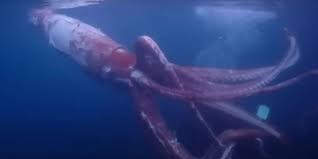Context:
A colossal squid has been filmed in its natural environment for the first time since the species was discovered 100 years ago near the South Sandwich Islands in South Atlantic Ocean.
More on the News
- Scientists captured footage of a baby colossal squid during a 35-day voyage to study species.
- The 30 cm (11.8 inches) long juvenile colossal squid was captured on camera at a depth of 600 meters (1,968 feet).
- Squid sightings are rare because they have highly sensitive eyes and tend to avoid bright, noisy research equipment.
- The footage was recorded in March 2025 by a team of scientists led by a University of Essex researcher during a 35-day expedition to discover new marine life.
- The sighting was announced on 16th April 2025 by the Schmidt Ocean Institute.
- In January 2025, Scientist captured footage of a glacial glass squid for the first time ever.
- Most knowledge about colossal squids comes from dead or dying specimens found in the stomachs of whales and seabirds, or from juveniles caught in trawl nets.
• The giant squid, a different species, was identified in 1857. However, a live giant squid was only photographed for the first time in 2004 and filmed on video in 2016.
- Giant squid also live in the frigid depths of the ocean, between 600 to 3,000 feet under the surface, in tropical and temperate waters.
- They primarily feed on deep-sea fish and other squid species.
Colossal Squid
- The world’s largest invertebrate, the colossal squid, officially named Mesonychoteuthis hamiltoni, was first described in 1925, based on specimens found in the stomach of a sperm whale.
- Experts believe colossal squid can grow up to 7m (23ft) in length and weigh up to 500kg (1,100lb), which makes them the heaviest invertebrate on the planet.
- This species comes under the Mollusca phylum.

- Distribution: Circumpolar around Antarctica and in the Southern Ocean
- Ecosystem/Habitat: Open Ocean (mesopelagic to bathypelagic)
- Feeding Habits: Ambush predator
- Taxonomy: Class Cephalopoda (squids, octopuses, and relatives), Family Cranchiidae (glass squids)
- It has been assessed for The IUCN Red List of Threatened Species in 2010. Mesonychoteuthis hamiltoni is listed as Least Concern.

CEPHALPOD:
- A cephalopod is any member of the molluscan class Cephalopoda such as a squid, octopus, cuttlefish, or nautilus.
- These exclusively marine animals are characterized by bilateral body symmetry, a prominent head, and a set of arms or tentacles modified from the primitive molluscan foot.
UPSC Mains practice Question
Q: In light of the recent sighting of a juvenile colossal squid, discuss its scientific significance, habitat, feeding habits, and challenges in studying this species.

